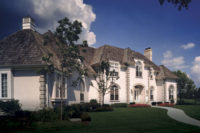For several months now, I have been getting a fair number of telephone calls from product manufacturers that want to tell me all about their new continuous insulation products. I gather from this that folks are paying attention to the new(ish) energy code requirements related to the building envelope. The majority of the callers are offering solutions that involve foam plastic insulation, so the showstopper question I always ask is “Have you got your NFPA 285 testing done?” The answers have included: “NF Pee ay two ayyy—what?” and “We don’t have to worry about that until 2015!” and “No but we’re thinking about it!” I have also received a couple of “Yes” answers but even these have turned out to be “sorta yes” (more on that later).
A short refresher course on the subject will be helpful in understanding the issue. In most climate zones in the U.S., energy codes require exterior building envelope assemblies made of steel studs to be thermally isolated with continuous insulation to eliminate thermal bridging. Although the requirement has been in existence for several years now, it is a practice relatively new to the industry, following in the footsteps of slow adoption of national energy codes and standards.
A simple, straightforward way to meet this requirement is to add a relatively thin (1- to 1½-inch depending on the climate zone) layer of foam insulation, typically extruded polystyrene, over sheathing, directly behind the cladding material. While this solves the energy code requirement quite elegantly with little change to standard wall assemblies, it runs smack up against a building code requirement that exterior wall assemblies containing foam plastic be tested in accordance with NFPA 285—Standard Fire Test Method for Evaluation of Fire Propagation Characteristics of Exterior Non-Load-Bearing Wall Assemblies Containing Combustible Components.Note the “Wall Assemblies” part of the title.
What Defines a Wall Assembly?
The big problem facing the construction industry with regard to NFPA 285 is the word “assembly.” As far as the NFPA is concerned, every component (down to the fastener) and every arrangement of every component (down to fastener spacing) in the assembly must be tested exactly as drawn to meet the standard. No piggybacking is allowed—any variation from one assembly to another requires a new test. Many product manufacturers are simply selling a single component of an assembly that has many components. This is where that “sorta yes” answer comes in.
Because the tests are expensive, manufacturers (that have done testing) have only done one or two—anything shown on the drawings that is not an exact match to the tested assembly does not meet the requirement. The foam plastic insulation manufacturer’s lobbied for code language allowing engineering judgment letters in lieu of actual tested assemblies, but the code officials declined. This has not prevented manufacturers from providing these letters to designers, but the designer is responsible for designing to building code requirements, which leaves the designer in a bit of a pickle.
The Ultimate Cladding Backup Assembly
In addition to foam plastic insulation, the building code is requiring that even more components in wall assemblies be tested in accordance with NFPA 285, most recently water-resistive barriers, further complicating an already complicated issue. Thankfully, there are systems available that satisfy all of these issues, and then some.
Called Insulated Composite Backup Panel Assemblies, these systems simultaneously perform as air, water, thermal and vapor barriers, in any climate zone. They can be used behind any type of cladding system, and have several NFPA 285 tests to choose from, for many cladding options. ICMBs are made by foaming insulation between steel skins with integral joinery to maintain an uninterrupted thermal barrier and concealed fastener penetrations. They are also very economical to install, replacing sheathing, water-resistive barriers, air barriers, vapor retarders, continuous and stud cavity insulation. The panels are installed directly over stud framing, and provide enough thermal insulation to eliminate mineral fiber insulation in the stud cavity, allowing conduit, pipe, etc. to run freely within the stud cavity space.
The panels are factory fabricated to exact sizes and configurations required, delivered to the project site pre-cut and sequentially packaged for fast, efficient installation. Projects have realized reduction in construction time anywhere from four weeks to over two months, depending on project size.
Manufacturers of these offer a full complement of details and excellent technical support. Warranties are also provided; one manufacturer offers a 10-year “Weathertight Wall Warranty” that covers leaks in the system as a result of a defect in the system or faulty installation.
Conclusion
Designing exterior wall assemblies that satisfy both energy and building code requirements is becoming more and more of a challenge. Greater and more widespread enforcement of building code requirements that exterior wall assemblies be tested in accordance with NFPA 285 is forcing the industry to take notice. Instead of painstakingly piecing together wall assemblies with multiple individual components like sheathing, water barriers, vapor retarders, and insulations, a new group of systems that does it all are readily available alternatives. In addition to solving water, air, vapor, and thermal issues, insulated composite backup panel assemblies have passed multiple NPFA 285 tests, with numerous cladding types attached. As an added bonus, these systems often result in lower cost and reduced construction time. What’s not to like? I haven’t found anything yet.








Report Abusive Comment